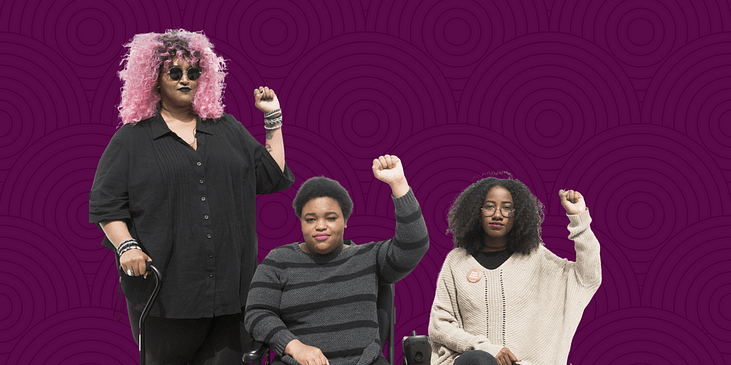By Hailey Hudson
The Disability Rights Movement established civil rights for people with disabilities, opening up opportunities for them to participate more fully in society.
This movement gathered speed in the 1960’s and led to the Americans with Disabilities Act (ADA) being passed in 1990. The United Kingdom would pass a similar legislation: the Disability Discrimination Act (DDA) in 1995. Many other countries across the globe followed suit with similar legislation throughout the 1990’s.
But the Disability Rights Movement fell short of examining how aspects such as the intersections of race, gender, class and sexuality play a role in the oppression of people with disabilities. That’s where Disability Justice comes into play.
What is Disability Justice?
Disability Justice is a term that was coined in 2005 by Sins Invalid, a collective of disabled queer women of color, including Patty Berne, Mia Mingus, and the late Stacey Milbern. Disability Justice builds on the disability rights movement, taking a more comprehensive approach to help secure rights for disabled people by recognizing the intersectionality of disabled people who belong to additional marginalized communities.
The Disability Justice framework asserts that we must include the experiences of multiply marginalized people with disabilities such as:
- People of color
- Immigrants
- LGBTQIA+ People
- Homeless people
- Incarcerated people
- People who have had their ancestral lands stolen
Disability Justice looks at all of these issues, recognizing how diverse systems of oppression interact and reinforce each other. Because of this broader focus, the Disability Justice movement is the most comprehensive way to create lasting change for people with disabilities and who are multiply marginalized.
Disability Justice has 10 main principles to examine the inclusion of people who are multiply marginalized, which Patty Berne outlined in a 2015 blog post:
1. Intersectionality
Intersectionality is a term founded by legal scholar Kimberlé Crenshaw in 1989 to address how Black women exist at the intersections of racism and sexism. Similarly, the Disability Justice framework applies this concept by explaining that disabled people each have a different background and experience regarding race, class, sexuality, age, immigration status, and other issues. Recognizing intersectionality means recognizing that abhorrent ideologies such as ableism, racism, sexism, xenophobia, homophobia, and transphobia often operate together and empower one another.
2. Leadership of Those Most Impacted
Disability Justice makes a point to center the leadership of the people most impacted by ableism rather than scholars and academics, or others who are disabled but still benefit from other types of oppression. The Disability Rights Movement has been criticized for prioritizing the voices of white disabled people, who have often continued to reinforce the racism and oppression that Black disabled people and people of color experience. Therefore, it is imperative to ensure that leadership, power, and opportunities are given to people most negatively impacted by the full spectrum of ableism to more effectively combat those issues.
3. Anti-Capitalist Politics
This principle essentially says that our worth as a person does not depend on how much we can produce. Disability Justice pushes back against the level of productivity a capitalist culture expects, as well as the systemic poverty that people with disabilities are forced into if they are unable to work. All people deserve to have their needs met, regardless of their ability to produce.
4. Cross-Movement Solidarity
Disability Justice combines with other movements seeking liberation — such as racial justice, environmental justice, anti-police terror, and others. Because every demographic of people includes people with disabilities, people with disabilities will not be liberated without the success of each of these movements. This effort helps disabled people to become more united and comprehensive in our activism.
5. Recognizing Wholeness
The Disability Justice movement holds that disabled people are whole people. They are not less than because of their disability. Disabled people have rich inner lives and valuable experiences.
6. Sustainability
Another vital principle of the Disability Justice movement is sustainability. Disabled activists and advocates need to be in tune with their bodies to pace themselves long-term and continue steadily working toward justice over time without burning out. Additionally, the sustainability of the movement is dependent on the community, and cannot be pushed forward by individuals alone.
7. Commitment to Cross-Disability Solidarity
Disability Justice focuses on all disabled people, including those who are often left out. Anyone who experiences ableism is included, whether they are chronically ill, neurodiverse, Deaf, Blind, mentally, intellectually, developmentally disabled, physically disabled, or have any other disability.
8. Interdependence
Interdependence allows us to work side-by-side, creating a stronger community as we work to liberate all oppressed individuals. Instead of solely promoting independence, which was a focus of the Disability Rights and Independent Living movement, interdependence acknowledges that none of us can thrive without support. This principle centers around building a sense of community among disabled people and organizing to achieve liberation.
9. Collective Access
The collective access principle explains that Disability Justice creates methods of doing things outside of nondisabled, neurotypical norms. In the Disability Justice movement, access needs are welcomed, respected, and acknowledged.
10. Collective Liberation
Collective liberation explains that disabled people move together as people with “mixed abilities, multiracial, multi-gendered, mixed class, across the sexual spectrum, with a vision that leaves no one behind.” This principle acknowledges the decades-long work of those who have previously fought for liberation while also acknowledging what is yet to be. Collective liberation means envisioning a world that can be created when disabled people with various backgrounds and lived experiences come together to enact a movement of change.
Moving Forward with Disability Justice
When we focus on the principles of Disability Justice, we prioritize the connections between ableism and other systems of oppression. Disability Justice recognizes that disability is not monolithic — ableism looks different for people with various disabilities as well as people of different races, classes, and genders. Thus, Disability Justice is the most potent and effective way to secure the liberation of disabled and multiply marginalized people.
Catch up on our latest blog posts here!

Hailey Hudson is a Freelance Writer for WID.


0 comments on “Moving From Disability Rights to Disability Justice”